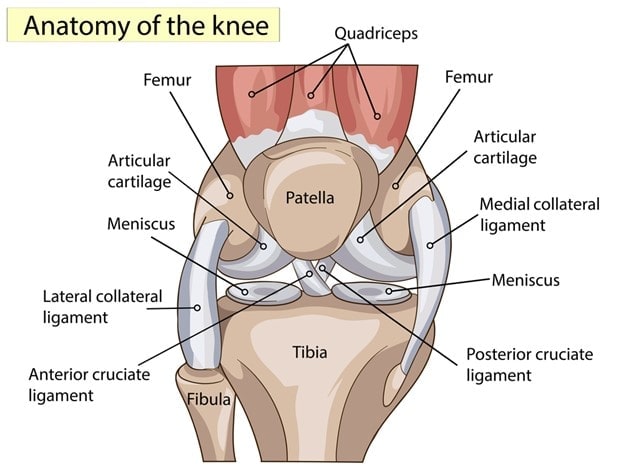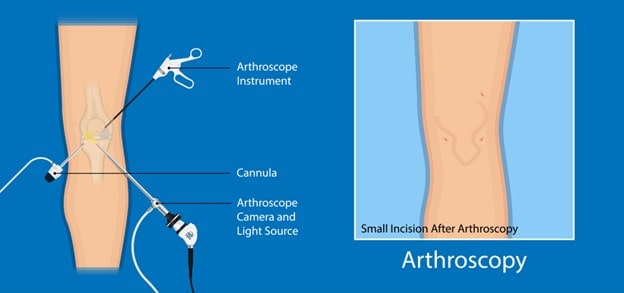Patient Resources

Arthroscopy is a surgical procedure in which a surgeon investigates and corrects knee problems with an arthroscope. It is one of the least invasive surgical procedures to diagnose and treat joints issues.
The arthroscope used in surgery is a small tool with a camera that allows doctors to inspect joint damages. During the procedure, the surgeon makes a tiny incision and enters the camera into the knee to view it from the inside on a screen to diagnose the problem and correct it with small instruments, if possible. Many conditions can be diagnosed using a scope including a torn meniscus or misaligned patella. The procedure times vary by the conditions but generally, you can return home within 1-2 hours post-surgery with minimal complications.
The popularity of this surgery is increasing because it is less invasive than traditional surgeries that require large incisions. Therefore, the procedure results in shorter recovery time, less pain, and joint stiffness. This procedure is the best option for you if you want to return to your favorite activities fast. We hope this page allows you to learn everything you need to know from the best Atlanta arthroscopic knee surgery experts.

To understand how this surgery works, you must know more about the anatomy of the joint. The knee joint is one of the largest and most complex joints in the body. (1)
Three main bones participate in the formation of the joint, which are the patella or kneecap, the upper end of the tibia or shinbone, and the lower end of the femur or thighbone.
In addition to the bones, other important structures include:
Knowing the anatomy will allow you to better understand your condition and be more aware of what our Atlanta Knee Arthroscopy surgeons explain to you before and after the procedure.
Some examples of when the surgery may be recommended include:
Our Atlanta Knee Arthroscopy team follows the following steps to prepare you for the big day:
Our Atlanta Knee Arthroscopy surgeon will require imaging and may require tests to assess your overall health before the surgery and identify if any problems may occur during the surgery. Examples of preoperative tests include blood tests or EKG.
If you do not have any health issues, you will likely be able to go home the same day as your surgery. Also, you should inform your orthopedic surgeon if you take certain medications or supplements regularly. You may be asked to stop taking them for a while before the procedure.
At our Atlanta Knee Arthroscopy center, we contact our patients and provide them with all the details and instructions about the procedure. You may be asked to stop eating or drinking before the procedure. Follow all the rules to avoid any complications during or after the operation.
Before the procedure, one of our anesthetists will provide you with all the details you need to know about the anesthesia you will receive. Different anesthesia methods include:
Our Atlanta Arthroscopic Knee Surgery team will discuss the best various methods with you.

Once you are in the operating room, the anesthesia will be given to you. Your skin and knee will be cleaned well to prevent any infections and surgical draping will be put on your leg exposing just where the incision will be done. After that, your knees will be stabilized using a positioning device to prevent any sudden movements during the procedure.
The orthopedic surgeon will start with portals, which are a few small cuts. Saline or sterile water will be used to remove any fluids to see clearly inside your joint.
When the view is clear, the surgeon will diagnose your condition. The scope will be inserted and the image will be shown on a screen to help the surgeon see all the details.
After that, tiny, specialized instruments will be inserted through the other incisions to perform the rest of the procedure and treat your condition.
The procedure time varies by condition depending on the problem and its treatment. After treating your condition, each cut will be sutured and the whole knee will be covered with a bandage.
The procedure is generally safe, and the risks and complications are rare. All surgeries have the following risks
Certain risks are associated with knee arthroscopy surgeries including:
After the procedure, patients are moved to the recovery room. Generally within 1-2 hours, they can go home. You should have someone to accompany you to your home and check on you during the first day.
Recovery is faster than other surgeries, but you must follow your doctor’s instructions until you fully recover. Knee scope surgery recovery time does not take long, and you will be back to your normal life after a few days to weeks.
You will feel some pain after the procedure, which is completely normal. Your surgeon will prescribe medication and in some cases, you may require opioids, but it is always better to avoid them, if possible. Our Atlanta Knee Arthroscopy team members will be in contact with you during your recovery process to ensure you are healing well and to answer any questions you may have.
You should keep your leg as elevated as possible during the first few days after the procedure along with applying ice on your joint to relieve any swelling and reduce the pain.
A dressing will be covering your joint when you leave our Atlanta outpatient surgery center. Follow your doctor’s instructions on how to keep the incisions clean and dry, when to have a shower, and how to change the dressing. After few days, you will visit your doctor to assess the progress and start a postoperative treatment program.
After surgery, most people need crutches for the first 2 to 3 days. Your surgeon will assess the condition and tell you exactly when you can put weights on your leg and foot.
Yes, rehabilitation exercises are necessary. You should do them regularly for a few weeks after surgery to restore the normal motion of your knee and leg and make your muscles stronger. Your doctor will show you some exercises to perform. After a few weeks, you should see a physical therapist who will help with your recovery.

Most patients take about one to three weeks after the procedure to be able to drive again. Your doctor will tell you when you can drive safely again.
Most patients return to their work after 10 to 15 days. However, if your work requires a lot of physical activity, your doctor may recommend recovering for a longer time and take certain precautions before going back to work.
Arthroscopic knee surgery is a common procedure. It involves small incisions, which minimizes soft tissue damages and complications. This surgery is recommended for many conditions and can help people get back to their daily activities sooner than traditional procedures. Contact Thrive today to schedule your initial consultation!
Get started on your treatment today!